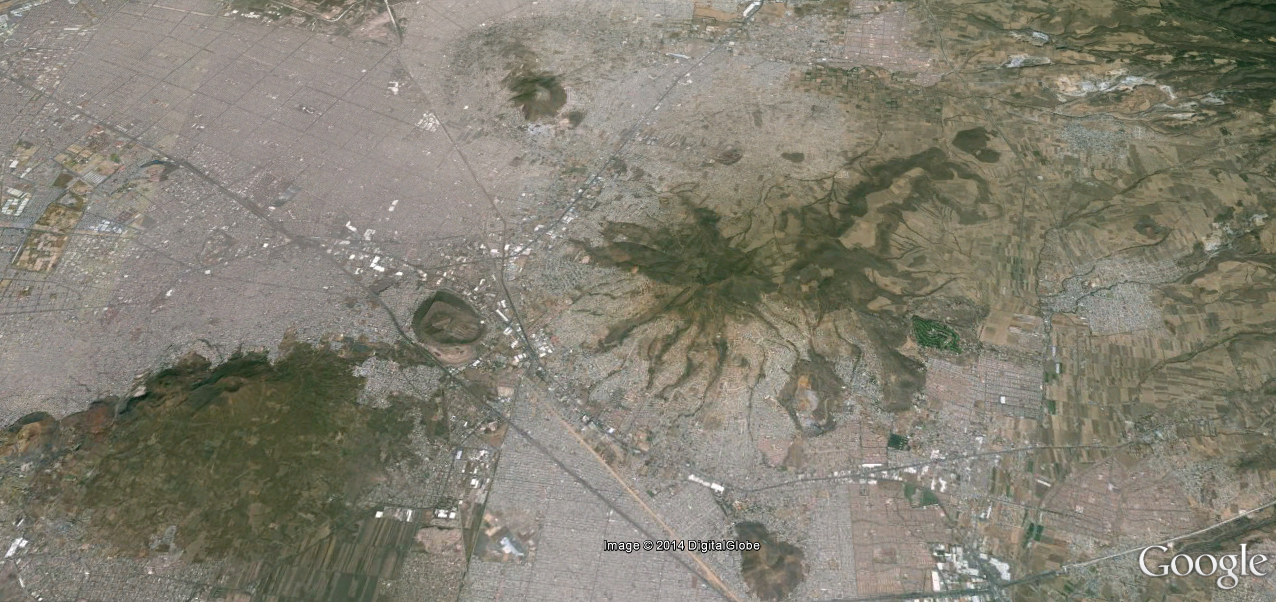 Source: Google Earth
Source: Google EarthWater availability in Mexico City, a metropolis with over 21 million people, is precarious due to climate change risk. Mexico City is using water two to three times faster than the natural recharge rate, and less than 8% of wastewater is treated. Analysis of various climate change models project temperature increases of 1–3°C and a precipitation decrease of about 7% by the 2050s. Temperature increases are associated with episodes of heavy rainfall in the rainy season, which is likely to increase flooding and landslides because the city lies in a closed basin with little natural drainage and steep slopes (Sosa-Rodriguez 2013).
Nearly 60% of the population lives below the poverty line. It is estimated that over 60% live in informal settlements—often in areas prone to flooding and landslides and that are crucial to aquifer recharge. Currently a large proportion of residents are in their 20s and 30s; as they age they will be more susceptible to heat waves and have decreased mobility in the face of inclement weather (Connolly 2003). There is willingness to address climate change issues; for example, the designation of the Conservation Zone and efforts to improve air quality. These efforts have had a positive impact; however, Mexico City has shown limited capacity to adapt at the necessary pace, as they have not been able to quell population growth and development in the Conservation Zone.
Based on the Risk Assessment Framework (Mehrotra et al., 2009), Mexico City needs to enhance climate change adaptation efforts. Its most recent climate change plan included 26 mitigation actions costing $4.3 billion with 12 adaptation actions costing $228 million. Adaptation is essential to water security, achievable through enhancement and enforcement of land use policies.
Mexico City’s first policy response should be to create the Mexico City Metropolitan Area Urban Sustainability Authority. It should work across state and district lines to tackle neglected issues that lie at the intersection of environmental development and urban planning. The MCMA Urban Sustainability Authority would derive its power from the Mayor of the Federal District and Governor of Mexico and be jointly led by the ministers of the environment and urban planning in each region. It would be composed of individuals working at a local level, representing specific municipalities in the MCMA. The Authority’s top priority should be to update or create water management plans for each municipality. These plans should address water use reduction, aquifer recharge and rainwater capture, and wastewater treatment.
Its second policy response should be to create the Conservation Zone Protection Corporation, whose mission will be to effectively manage the peri-urban zone in the southern part of the city (Aguilar and Santos 2011). Uninhabited land will be used for recreation, education, tourism, and forestry. The corporation will be funded through sponsorships, permits, and rent. The fees will be used for administrative costs and provide grants for farmers and residents.
This article is a product of Professor Shagun Mehrotra’s Climate Change and Cities class. Views expressed are entirely those of the authors.
References
Aguilar, A.G. and Santos, C. (2011). Informal settlements’ needs and environmental conservation in Mexico City: An unsolved challenge for land-use policy. Land Use Policy, 28, 649-662.
Connolly, P. (2003). Urban slums reports: The case of Mexico City, Mexico. The Challenge of Slums: Global Report on Human Settlements 2003, 195-228.
Mehrotra, S., C.E. Natenzon, A. Omojola, R. Folorunsho, J. Gilbride & C. Rosenzweig. (2009). Framework for city climate risk assessment. Washington, DC: World Bank.
Sosa-Rodriguez, F.S. (2013). From federal to city mitigation and adaptation: Climate change policy in Mexico City. Mitigation and Adaptation Strategies for Global Change, doi:10.1007/s11027-013-9455-1